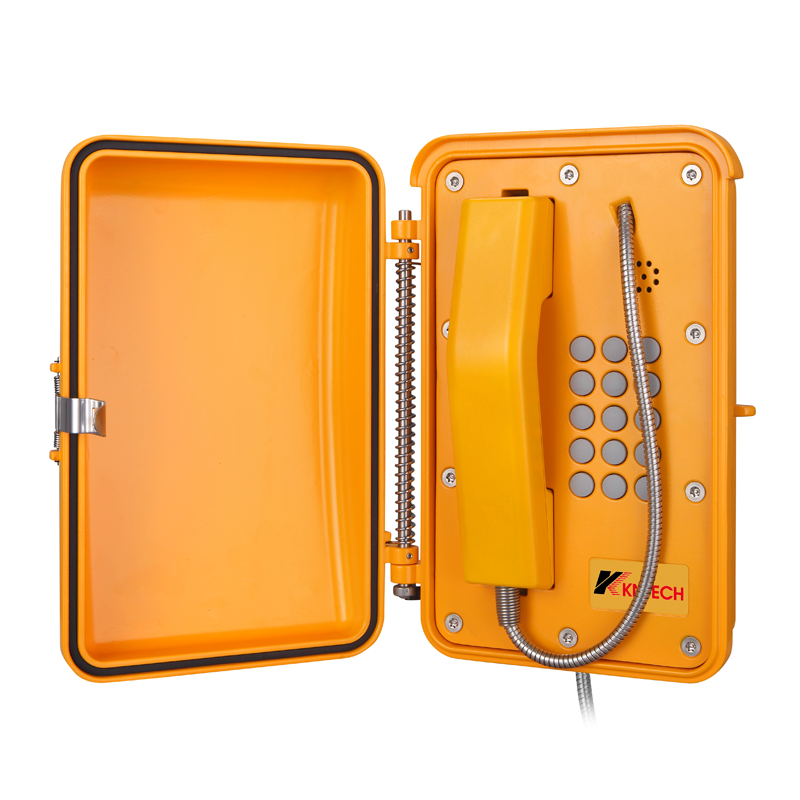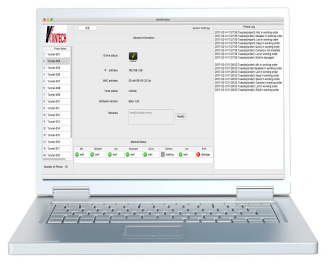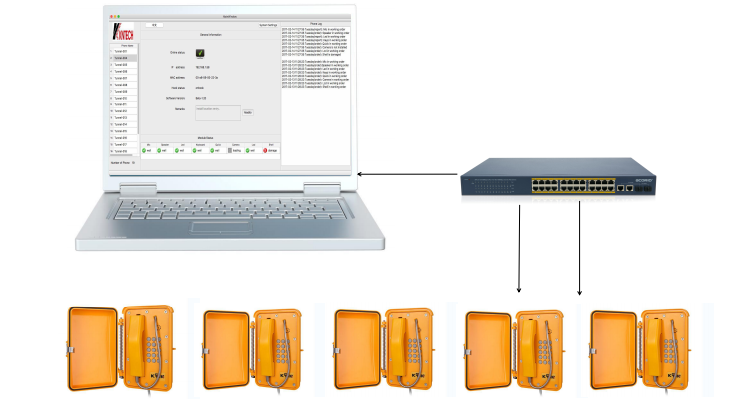
 (6).jpg)
Système d'autodiagnostic téléphonique (TSS-1000)
KNTECH Telephone Management System is design for control office to monitor the Emergency Call Pointin real time to make sure all the phone station are in good working status. Ensure the control office knowimmediately if one telephone broken and can send someone out to repair it.
TSS-1000 is operating basis on Windows software package use on a PC having the Microsoft Windows. Consist of one windows software + the Emergency call point KNSP-19. All the Emergency Call Point devices have a monitoring and self-diagnostic functionality. Including automatic self-test of microphone and loudspeaker with configurable plan for how often this self-test runs automatically.
At Least every 24 hours, all the Emergency Call Point shall send their health/fault status to the control room TSS-1000 to display the status at the control room. This data also be available to any relevant subscriber of monitoring data as for maintenance purpose.
Details on symbols, icons and color codes to identify objects monitoring status are designed for Employer’s easy operation.
The system is highly reliable. Simply installation and Operation. Just running the TSS-1000 in your computer.
Phone call is higher priority while perform a self-checking task.
The reomote testing and programmable include below details:
Self Monitoring and diagnose
The telephone will report to the TSS-1000 in real time when below happens:
a. Keypad or emergency call button get stucked.
b. Handset microphone or receiver broken, or handset cord broken.
c. Ring indicator LED broken.
d. Buzzer broken.
e. Telephone box been opened
| Modèle | Téléphone KNSP-19 avec système de diagnostic |
| Construction | Corps moulé en alliage d'aluminium robuste |
| Dimensions (W * H * D) | 320*205*120mm |
| Poids | 5.7kg |
| Température de fonctionnement | -25°F to +158°F/ -40℃ to +70℃ |
| Humidité relative | Jusqu'à 95% sans condensation |
| protection | Conception IP66, résistant au vandalisme et à l'eau |
| la communication | Communication bidirectionnelle en mode duplex intégral |
| Signalisation de contrôle d'appel | Informations SIP (DTMF), RFC 2833 (DTMF) |
| Codes audio | G.711, G.722, G.729 |
| Puissance | Alimentation par Ethernet, IEEE802.3af, Classe 0 Alimentation locale, 12VDC, Idle 2W, Max 10W |
| Contacts auxiliaires | 1 sortie auxiliaire, contact sec |
| Notes de contact | |
| Charge: charge résistive | |
| Charge nominale: 0,3 A à 125 VCA; 1 A à 30 VDC | |
| Courant de transport nominal: 1A | |
| Tension de commutation maxi: 125 VAC, 60VDC | |
| Courant de commutation max .: 1A | |
| Réseau | Ethernet 10/100 BaseTX, connecteurs RJ45, Cat5e ou supérieur |
| Protocoles IP | IPv4, TCP, UDP, TFTP, RTP, RTCP, DHCP, SIP |
| Protocoles LAN | Alimentation par Ethernet (PoE, 802.3af), WLAN (IEEE 802.3af), accès réseau |
| Contrôle (IEEE 802.1x), STP (IEEE 802.1d), RSTP (IEEE 802.1d-2004) | |
| La programmation | Programmation et configuration de mémoire flash non volatile via une interface graphique Web |
| Gestion et exploitation | DHCP et IP statique, mise à niveau automatique du logiciel à distance, surveillance centralisée, voyant d'état |
| Code d'annulation d'écho | G.167/G.168 |
| Clavier | 0 ~ 9 numéros gratuits, recomposition du dernier numéro composé, numéros abrégés 1 et numéros abrégés 2 |




 (3).jpg)
 (5).jpg)
 (4).jpg)

 (2).jpg)